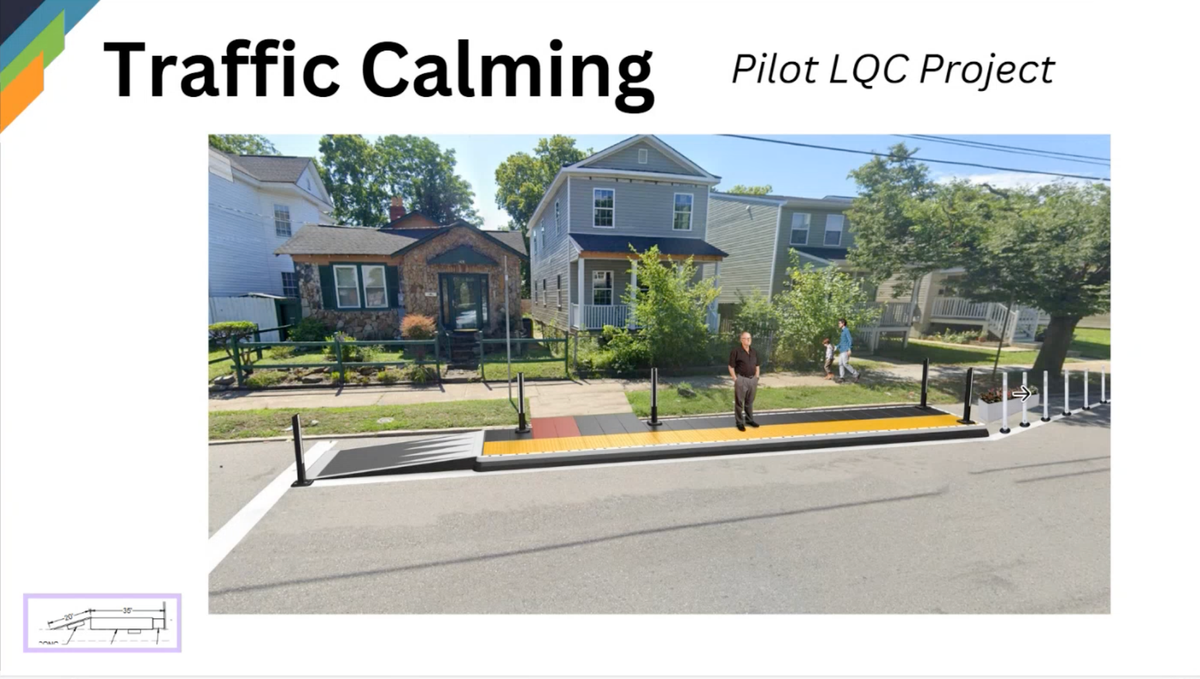Overcoming doubts, Richmond Planning Commission OKs test of new type of bus platform

After requesting and receiving more information from city officials, the Richmond Planning Commission approved a plan to test a new type of bus platform that could also help slow down traffic.
The Planning Commission voted 7-0 last Tuesday to greenlight the installation of a temporary platform in the 1400 block of Mechanicsville Turnpike near the intersection with Brauers Lane.
The bus platform — expected to be installed within a month or so — will be one of several new features meant to slow down traffic on a stretch of road near Martin Luther King Jr. Middle School, where nearby residents have told city officials that crossing the road can feel hazardous due to speeding.
Last month, the Planning Commission raised doubts about whether the bus platform would improve safety as promised or create new hazards of its own.
Because the platform will be built in the street, it will enable buses to stop in the travel lane instead of pulling to the side of the road. That means vehicles following behind a bus would have to stop and wait. Some commission members were worried that could encourage drivers to try to pull around stopped buses, risking collisions with oncoming vehicles or nearby pedestrians.
However, data presented at Tuesday’s meeting seemed to ease those concerns.
Kelli Rowan, who works in the city’s Office of Equitable Transit and Mobility, said D.C. has already installed almost 90 of the platforms, which are also known as bus bulbs.
Data from one D.C. bus corridor where they’ve been put in showed a 34% reduction in crashes, Rowan said, and Richmond intends to test a single platform to see if similar results will happen here.
Within a month of the platform’s installation, she said, the city hopes to have initial feedback and observations and GRTC bus drivers about how the new feature is working. After three months, the city expects to have early data showing the project’s impact on vehicle speeds. One year after the installation, Rowan said the city will have a full report on traffic safety in the area.
“Our office is taking these projects truly as tests,” Rowan said.
Guy Roach, a capital improvement project manager at GRTC, said the city already has some transit corridors where buses stop in a travel lane, such as the section of Route 20 that runs along Robinson Street between Broad and Cary Streets. Between January of 2016 and April of 2024, Roach said, there have been 153 crashes on Robinson.
“Zero of them resulted from vehicles crossing the centerline,” he said. “So that’s a good indicator that folks are being pretty well behaved with our buses stopping on this route.”
Rowan said that if the new platform does create issues with vehicles crossing the centerline to pass buses, the city could potentially install flexible posts on the centerline to discourage that.
Throughout the presentation, city officials stressed that the project was a direct response to the concerns of residents in the area. Delivering on the project, said the Office of Equitable Transit and Mobility’s Chenice Brown, would send a broader signal that the city is responsive to bottom-up suggestions.
“Every community deserves to be safe,” Brown said.
Several local groups that focus on transit and road safety urged the Planning Commission to approve the project.
“You don’t see these things getting ripped out of other cities across the country,” said Brantey Tyndall, director of the Bike Walk RVA program for Sports Backers. “And there’s a reason for that. It’ll work here too.”
Stephanie Power, community engagement and programs manager for RVA Rapid Transit, said the platform will make the area safer for bus riders “who are also pedestrians first and after they get off the bus.” For too long, Power said, riders “have been forced to wait in unsafe conditions, navigating unpredictable and high-speed traffic to cross the street.”
Despite the unanimous vote, some Planning Commission members continued to express reservations about the sheer variety of traffic calming measures deployed across the city.
“Wherever you are in the city, it’s different,” said commissioner member Brian White. “It’s confusing for drivers who aren’t on that road on a regular basis. And they may not understand what’s being asked of them by these changes.”
Planning Commission Chairman Rodney Poole thanked Rowan for what he called an “exceptional presentation” that addressed many of the questions members had raised at their last meeting.
“I do want to thank you for the thoroughness with which you responded in a two-week period of time,” he said. “I’m amazed.”






